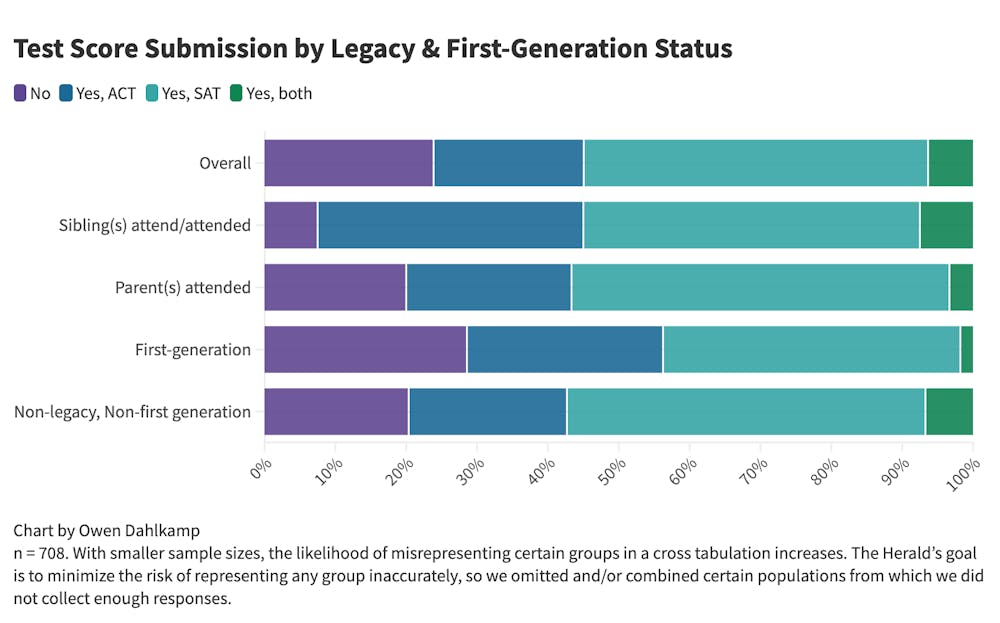In The Herald’s first-year poll conducted this summer, respondents were asked, among other topics, about the content of their applications to Brown, their personal backgrounds and how they navigated the college admission process.
As a University ad-hoc committee considers legacy status, test scores and early decisions, the poll — not a complete representation of the first-year class, but a snapshot of more than 700 students — offers insights into how those elements interacted with the backgrounds of first-years. While the poll does not entirely align with institutional demographic information, its proportion of respondents who received financial aid and submitted standardized test scores mirrors the University’s actual demographics.
The Herald examined how backgrounds differed among students who submitted standardized test scores, applied early decision, took advanced or college-level courses, submitted video introductions and hired independent SAT or ACT tutors and college counselors.
Test score submission
In recent years, application rates of low-income students have increased at schools with test-optional policies, a handful of surveys have found.
The University has followed a test-optional policy for the SAT and ACT since the 2020-21 application cycle, but poll respondents from different backgrounds reported different rates of score submission. Recruited varsity athletes who responded to the poll, for instance, were almost twice as likely to not submit scores as students who are not varsity athletes. And roughly half of first-generation respondents submitted test scores, compared to four-fifths of non-first-generation respondents.
Respondents who receive grants from the University covering all costs were four times as likely to not submit scores as those not receiving financial aid.
92% of respondents with a sibling who has attended Brown submitted test scores, the highest rate of any demographic. Parental education was also indicative of submission: Respondents whose parents hold advanced degrees were more likely to submit test scores than respondents whose parents did not.
Independent standardized test tutors, which some families hire to prep students for the ACT and SAT, represent another piece of the puzzle.
Respondents who used these consultants were most likely to be legacy students whose parents attended the University, non-first-generation students, students not receiving financial aid, students who attended private high schools and those whose parents attained advanced degrees.
High school type and international status did not show any significant impact on score submission.
Who applies early decision
In 2001, the University switched from a non-binding early application process to a binding early decision process after debates over which policy would be most equitable and reduce the workload of admission officers, The Herald previously reported. Now, the policy is under consideration again.
One of the most salient factors in applying early was legacy: Nearly 80% of respondents with a parent or sibling who attended Brown applied through the binding program.
65% of respondents who attended private high schools applied early decision, compared to 49% of respondents who attended public schools.
Parental education was also indicative of these trends, with increased parental educational attainment increasing the likelihood of applying early.
Sara Harberson, an independent college counselor, noted that applicants may be concerned about applying early because they cannot compare financial aid packages among prospective schools, she added.
Respondents who receive financial aid were much less likely to have submitted their application via the binding program. Just 38% of students receiving grants covering all costs applied early decision.
Logan Powell, associate provost for enrollment and dean of admission, wrote that the University’s financial aid program has allowed the Office of College Admission “to attract a remarkably diverse and talented applicant pool.”
Given this, “the diversity of our early decision admitted cohort is almost identical to that of the overall student body, both in terms of racial diversity and first-generation status,” he wrote.
The ad hoc committee is “exploring the impacts of our existing practices” and will “make data-informed recommendations,” University Spokesperson Brian Clark said.
College-level courses, video introductions
When considering an applicant’s academic credentials during the review process, the Office of College Admission “focuses on admitting students who demonstrate excellence in context,” Powell said in an interview with The Herald.
But this context can differ based on the type of high school a student attended.
Respondents who attended private high schools were far more likely to indicate that their school did not offer Advanced Placement or dual enrollment courses — which allow high school students to take courses at colleges — than their peers who attended public schools. Public school students also took far more advanced courses when offered.
Private high schools that do not offer AP classes “know that their students are not disadvantaged in the admissions process because admissions officers are truly trained to look at what the student took advantage of at their high school,” Harberson said.
“In each case, we consider the rigor of coursework an applicant has taken relative to what is available to them,” Powell wrote.
Another element of applications is the video introduction: After the permanent elimination of alumni interviews last year, the University still offers students the option to submit a two-minute video as part of their applications. The Office of College Admission encourages applicants to use this component to “tell us more about yourself, in your voice, beyond the information you provided in your application.”
Over 80% of respondents chose to submit a video, with respondents who applied through early decision or who have legacy ties being especially likely to submit one.

Owen Dahlkamp is the managing editor of newsroom on The Herald's 135th Editorial Board, overseeing the paper's news operations. Hailing from San Diego, CA, he is concentrating in Political Science and Cognitive Neuroscience with an interest in data analytics. In his free time, you can find him making spreadsheets at Coffee Exchange.





